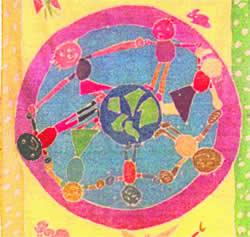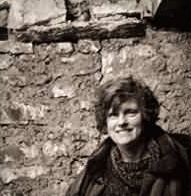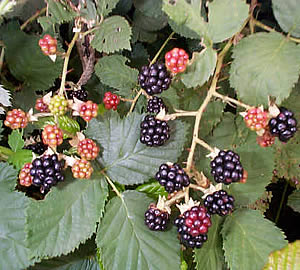Excerpt from
A City Herbal by Maida Silverman
BLACKBERRY (Rubus species)
Pg. 12-19
Folknames: Bramble, Scaldhead, Fingerberry,
Black Longberry
Location: Road embankments, parks, along fences of
vacant lots, and waste areas
Botanical Description: Blackberry
canes (as the stems are called) may be trailing, arched, or upright.
They are quite flexible and sometimes bend down to the ground and
root at the tip. Upright canes may grow more than six feet tall. The
compound leaves are dark green with three- or five-lobed leaflets.
The are variable in size and shape and have toothed edges. The illustration
is a typical example, and both three- and five-leafed specimens grew
on the same plant.
Blackberry blooms from mid- to late June. The masses
of white or pale pink flower clusters make the plants conspicuous
and easy to spot and remember for future berry picking. In the eastern
part of the United States, Blackberries start ripening toward the
middle of July. They are small, green, hard, and sour at first, becoming
larger, and when fully ripe, juicy and sweet. Ripe and unripe berries
frequently appear on the plants at the same time.
More than two hundred species of Blackberry are found
in the United States. Some are low, trailing, and vinelike; others
are large bushy plants. In the Northeast, purple-black berries are
most common, but other varieties may be red or even white when ripe.
Everyone loves the delicious fruit, and Blackberries of one kind or
another can be found throughout the United States.
Blackberries are perennials that reproduce from seeds.
The bushes are usually armed with thorns best described as vicious;
they seem to deliberately reach out and grasp the clothing and skin
and can inflict painful scratches on a careless picker. The thorns
themselves have a nasty tendency to break off at the tip and become
embedded in the skin. The eating more than makes up for the picking,
however. The only other way to obtain Blackberries is to buy them,
and they can be purchased only at gourmet greengrocers for a brief
time during the summer, at a cost of about two dollars for a mere
half-pint!
Historical Lore, Legends, and Uses:
The word bramble is said to be derived from the Old English word brymble,
meaning “prickly,” and bramble can also mean “any
thorny bush.” Another source explains the word as coming from
the Anglo-Saxon word bramel, itself derived from an older word, brom,
meaning “broom.” In earlier times, the thorny branches
of the Blackberry tied to a stick were used to make a broom for sweeping.
In England, the word “bramble” is used as a verb; the
expression “going brambling” means going Blackberry picking.
The Blackberry has long been appreciated for the taste of the ripe
fruit and valued for its medicinal properties. Many writers did not
even bother with a botanical description of the plant, saying instead
that “it is so well known it needs no description,” or
“it grows in almost every hedge.” It is difficult to overestimate
the faith people once had in the healing powers of this plant. The
astringent and binding properties were familiar to all who wrote about
Blackberries and all parts of the plant—leaves, roots, flowers,
and ripe and unripe berries were used. Preparations containing Blackberry
were used to treat diarrhea, dysentery (often called “bloody
flux”), various stomach disorders, and were believed valuable
for healing irritations of the mouth and throat. Eating young shoots
was even credited with fastening loose teeth in the gums! Infusions
of the roots and leaves and syrups prepared from the berries added
to wine were the usual methods of administering.
The Leechbook of Bald, a tenth-century Anglo-Saxon
treatise on plants and herbal remedies, recommended preparations of
Blackberry. For “flux in women” a tea was made from the
berries and drunk for three days while fasting. For “heart-ache”
the fresh leaves were pounded and laid over on the wound.
One Tudor herbalist recommended taking Blackberry juice
mixed with wine and honey for the “passions of the heart.”
He observed, “The sweet ripe fruit is very effectual, besides
the facility and pleasantness in taking.” Another herbalist,
Dr. William Coles, prescribed Blackberry as a remedy for “heartburn,
as some call it, which is a gnawing in the stomach from choler.”
(“Choler” is an old word meaning anger.” This particular
writer was apparently aware of the connection between emotions like
anger and physical illness, especially stomach and digestive disorders.
He noted that “the distilled water of {Blackberry} branches,
leaves, flowers and fruit is very pleasant in both taste and smell
and is excellent for feverish persons.” At the end of his extensive
treatise on the virtues of Blackberry, Dr. Coles decided to include
the following homily: “The people of Norway use their bramble
against scurvy and other melancholy diseases, so that we may admire
the wonderful wisdom of God, who has ordained to grow in every climate
remedies for those diseases whereunto it is subject.” The doctor
was no doubt rebuking his fellow Englishmen and women, who at that
time were abandoning their native medicines in favor of foreign imported
herbs, which he believed were greatly inferior.
The young roots and the root bark of the older plants
were most favored for medicinal use. These contained the greatest
amounts of valuable tannic, malic, and citric acids, and thus produced
the strongest tonic and astringent effect.
The dried or green leaves were used to prepare gargles
and heal sores and irritations of the mouth and genitals. One seventeenth-century
writer states that “the powdered leaves strewn on running sores
heals them.” A decoction of the leaves was also valuable for
treating stomach upsets and women’s ailments. And infusion of
the unripe berries was highly esteemed for curing vomiting and loose
bowels. A wash for the hair (the leaves boiled in lye!) cured head
sores and made the hair black.
Home remedies for the digestive ailment that frequently
resulted from drinking unwholesome milk or water and eating tainted
meats were kept on hand until well into the twentieth century, and
this is still done in rural areas. Every kitchen has a supply of dried
Blackberry leaves, roots, and berries on hand, as well as Blackberry
jam, cordial, and syrup. The Pennsylvania Dutch used the leaves, roots,
and fruit to ease indigestion, and preparations of the root were valued
for treating diarrhea.
In China, several varieties of Blackberry were described
and employed medicinally. The Chinese believed the fruit strengthens
the “virile powers” and increases the “yin principle,”
in addition to giving vigor to the whole body. Preparations of the
young shoots were used to improve the complexion and treat colds and
fevers.
Blackberry was a familiar medicinal plant to native
Americans. The Cherokee Indians chewed the root to ease coughs and
used cold poultices to relieve hemorrhoids. Delaware Indians made
a tea from the roots, which they used to cure dysentery, and the Oneida,
Catawba, and other tribes were familiar with the root and used it
for similar diseases.
At one time, Blackberry root was an official drug listed
in the United States Dispensatory. A fluid extract for treating diarrhea
was listed as recently as 1955.
From antiquity down to the present day, an astonishing
amount of folklore and superstition have become associated with the
Blackberry. Classical Greek writers, aware of the genuinely useful
properties of the Blackberry, were convinced that the plant had the
power to cure the bite of poisonous creatures. This belief persisted
for centuries. In addition, Blackberry was credited with having a
special affinity for women. The origin of this belief is lost in time,
but perhaps the fertile habit of the plant or its many-seed fruit
was associated with the hoped-for fertility of women. In any event,
Blackberry has for centuries been used to treat the disorders connected
with menstruation, conception, and childbirth. Usually taken as a
tea, the berries and leaves are still used by women in many parts
of the United States and Europe.
The speed and efficiency with which the Blackberry bush can transform
an area of open land into a virtually impenetrable forest of menacing
thorns has made a tremendous impression, as testified to by the wealth
of examples found in folklore: Sleeping Beauty protected by the bramble
forest for one hundred years; Rapunzel whose lover falls into the
bramble patch and is blinded by the thorns; and our own Br’er
Rabbit are a few examples of many. The bramble is also said to be
the Burning Bush from which God spoke to Moses, and from which the
Crown of Thorns that tormented Jesus was fashioned.
The Anglo-Saxons believed Blackberry had the power
to undo witchcraft. Christian faith and a pagan belief in the magical
power of numbers (especially 3 and 9) are combined in the following
charm “against any evil rune {witchcraft} and for one full of
elvish tricks” (under enchantment): “Take Bramble Apple
{Blackberries}, pound and sift them, put them in a pouch, lay them
under the altar and sing nine masses over them. Then put this dust
into milk, drip Holy Water three times upon it and drink every three
hours.”
Another prescription, “a good salve against the
temptations of the Fiend: and for a man full of elfin tricks,”
required ten different herbs, bramble included. These were pounded
together, boiled in butter, and the resulting broth was strained through
a cloth and set under a church altar. Nine Masses were sung over it
and then “the man was smeared on parts of his body.”
A peculiar contrast to the pleasure derived from eating
the fresh, ripe Blackberries was the superstitious belief, in many
areas in the British Isles and France, that Blackberries were unwholesome
and even dangerous to eat. Thomas Green, a nineteenth-century British
herbalist, mentions that “in some places Blackberries are called
Scaldberries, from their supposed qualities of giving a disease called
Scaldhead to children who eat them in immoderate quantities, as children
will, when they can obtain them.”
In many parts of England there was a widespread belief
among country people that it was unlucky to gather or eat Blackberries
after Old Michealmas Day (October 11). Legend had it that Satan was
thrown out of heaven on that day, and fell into the bramble bush,
whose thorns caused him great pain. Ever since that time, on the yearly
anniversary of his fall, he “spoils” the berries by spitting
or breathing on them. Anyone foolish enough to eat any after that
day will have bad luck, become ill, or perhaps even die. In one district,
Blackberries were not eaten at all until quite recently, it being
believed that “the trail of the Serpent” was upon them.
Blackberries were ruled by the planet Mars, and to
dream of them foretold the future. It was generally a bad omen if
you dreamed you walked through a bramble patch. If the thorns pricked
you, secret enemies would do you harm through a trusted friend; if
the thorns drew blood, you were to expect serious business reverses.
If you passed through unharmed, however, you would triumph over your
enemies.
In Cornwall, Blackberry leaves were employed to heal
burns in a magical ritual of ancient origin. Water from a holy well
was poured into a basin, and nine Blackberry leaves were floated on
the surface. One at a time, each leaf was passed over and away from
the afflicted area, the operator saying three times over each leaf:
There came three angels out of the East.
One brought fire and two brought frost.
Out of fire and in frost,
In the name of the Father, Son, and Holy Ghost.
A variant of this charm was to lay the leaves on the
skin; as they fell off, so would the burns heal.
Perhaps the most fascinating belief of all is the legendary
efficacy attributed to the “bramble arch.” One sixteenth-century
writer noted that “every one that hath seen it is able to say
that it {Blackberry} shoots forth many long, ribbed branches, which
by reason of their length and weakness bend down to the ground again,
there many times taking root.” It was widely held that certain
diseases could be cured by having the patient creep or be passed through
this natural arch. The belief in this cure extended to animals as
well as humans. In Normandy, until the latter part of the nineteenth
century, cattle were regularly herded through these natural arches
to cure them of lameness.
The bramble arch was considered even more powerful
if the original plant was growing on one person’s land and the
tip of the cane had rooted on the property of another. It was very
bad luck to destroy one of these arches or deny sick persons access
to them. In Essex, a person (usually a child) suffering from whooping
cough would be made to crawl under the arch seven times from east
to west, saying each time; “In bramble, out cough, here I leave
the whooping cough.” A small cross fashioned from the thorny
stems was worn on the person to ward off the disease, or aid in the
cure if one was already ill.
Children were passed through the bramble arch to cure
rickets and skin diseases as well. Along the Welsh border, after the
child had crawled or been passed through, he was given a slice of
bread and butter. The child consumed half the slice, and the other
half was left under the arch. It was hoped that a bird or animal would
eat this remaining piece and take the disease unto itself; the animal
would then eventually die and the child would recover. Minor complaints
such as rashes and boils could also be cured by crawling under the
bramble arch three times from east to west.
All these rituals were meant to strengthen the cure.
The healing powers of Christianity, the magic force of certain numbers
such as 3, 7, and 9 as well as the life-giving force of the east-to-west
“sunrise turn” would, it was hoped, enhance the recognized
healing virtues of the Blackberry.
Suggested Uses: A modern writer suggests
rubbing crushed fresh leaves on insect bites and scratches to relieve
them, especially those received from the thorns of Blackberry bushes!
An infusion of the leaves is said to be useful for
soothing sunburn, and other minor burns. I have used a syrup of the
ripe berries to relieve upset stomachs and nausea, and to soothe sore
throats and coughs.
In addition to the delights of eating freshly gathered
Blackberries with cream and sugar, baked into pies, or made into jam,
here are some additional ways to enjoy them.
BLACKBERRY SYRUP
Put ripe berries into a large pot and mash very gently
with a potato masher. Add water to barely cover the berries, and cook
over low heat until the steam rises and they start to give up their
juice. Remove from heat and strain to remove seeds. Measure ½
cup of white sugar or mild-flavored honey (such as clover) for each
cup of Blackberry juice, mix together the sweetening and juice, and
reheat slowly only until sweetening is dissolved. Try not to let the
juice or syrup boil, since this tends to destroy the appealing fresh-berry
flavor. Keep syrup refrigerated in jars. (It may also be frozen, and
keeps very well both ways.)
Blackberry syrup may be poured over cake, pancakes,
or ice cream, and stirred into fresh fruit compotes. A few spoonfuls
may be added to hot tea, and a pleasant drink may be prepared by adding
1 cup of boiling water to about an ounce of Blackberry syrup, along
with a slice of lemon and sugar or honey to taste. This is especially
welcome on a cold day, or before retiring.
BLACKBERRY CORDIAL
Prepare syrup as for Blackberry syrup (preceding recipe),
or if you wish a sweeter cordial, allow 1 cup of sugar to each cup
of juice. You may spice the syrup with nutmeg, cinnamon, allspice,
or cloves, the combination and amount to your own taste. (Crush whole
spices yourself. Do not use store-bought powders.) Boil syrup gently
for about 10 minutes, then strain out the spices. You may use ½
cup of vodka (or brandy if you prefer) for each cup of syrup, or equal
amounts of spirits and syrup. Store in tightly covered bottles.
BLACKBERRY VINEGAR
Barely cover ripe berries with malt or cider vinegar,
gently crush to allow juices to flow, and let stand three days. Strain,
allowing juice to drip overnight. Measure juice, and add ½
cup of white sugar or mild honey for each cup of liquid. Mix together
and boil gently until sweetening is dissolved. Skim off any scum that
forms. When cool, bottle and cap tightly. A teaspoonful mixed with
water is an excellent thirst quencher, especially welcome during feverish
colds and coughs.
BLACKBERRY-LEAF TEA
Allow 1 heaping tablespoon of dried Blackberry leaves
per cup of boiling water, cover, and steep 10 minutes. Strain and
add honey or sugar to taste. You can combine equal amounts of dried
mint and dried Blackberry leaves—and excellent combination.
Dried Blackberry-leaf tea makes an excellent astringent
wash for oily skin. Prepare as for Blackberry-leaf tea, using ¼
cup of leaves. Let cool to tepid, strain, pressing out all liquid,
and pat gently on your skin.
To dry Blackberry leaves: Pick leaves
dearest the growing tips (from midspring to midsummer) in the morning
when the dew has dried off. Lay on screens or hang up in small bunches
out of the sun, but in a dry airy place. When thoroughly dry, they
will be crisp and brittle. Strip the whole leaves carefully from the
stalks, and put away in jars. The leaves should retain their green
color. To best preserve the active properties of the plant, do not
crumble the leaves until you are ready to prepare the tea.
BLACKBERRY TEA
To prepare a tea with the dried green Blackberries,
use 1 heaping tablespoon of berries. Pour boiling water over them,
and allow them to steep 15 minutes. Strain, and add sugar or honey
to taste. I have found this tea useful to ease mild stomach upsets.
To dry berries: Generally speaking,
it is the green, unripe rather than the ripe Blackberries that are
dried because the valuable astringent principle is strongest in the
unripe berries. Make sure clusters are free from moisture when picked,
and dry as described above for the leaves. They will take longer than
the leaves, and will shrivel considerably. Put away only when thoroughly
dry, or they will mold.
Blackberries are delicious in apple pie. Add about
1 cup or more if you wish to pie filling.
To freeze berries: Was gently and
let dry thoroughly before freezing in plastic bags. It is not necessary
to thaw before using.
Blackberry plants are a fine source of natural dye.
A terra cotta color can be obtained from the leaves, and purple-brown
from the ripe berries. See the Appendix, page 171, for instructions
on preparing dye.
Excerpt from
A City Herbal by Maida Silverman
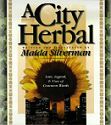


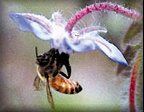
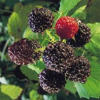
 We
have the power
We
have the power 











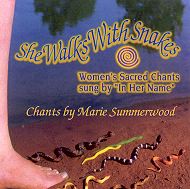



 ORDER
HERE
ORDER
HERE